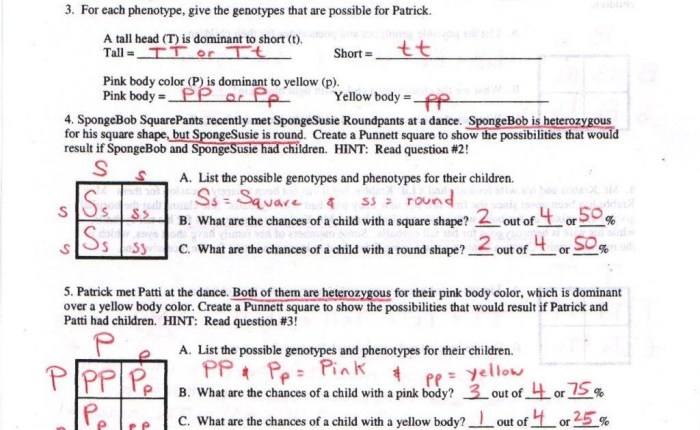Embark on a scientific expedition with Chapter 10 Dihybrid Practice Problems Answer Key, your definitive guide to unlocking the intricacies of genetic inheritance. This comprehensive resource unravels the fundamental principles of dihybrid inheritance, empowering you with the knowledge to solve complex genetic problems and unravel the secrets of genetic variation.
Delve into a world of Punnett squares, probability, and the practical applications of dihybrid inheritance in breeding programs and real-world scenarios. Prepare to expand your understanding of genetics and witness the power of scientific inquiry firsthand.
Dihybrid Inheritance: Chapter 10 Dihybrid Practice Problems Answer Key

Dihybrid inheritance refers to the inheritance of two different traits simultaneously. It was first studied by Gregor Mendel in his experiments with pea plants. Mendel’s principles of dihybrid inheritance provide a fundamental understanding of how genes interact and are passed on to offspring.
The principles of dihybrid inheritance state that:
- Each parent contributes one allele for each trait.
- Alleles segregate independently of each other during gamete formation.
- Fertilization results in the random combination of alleles from both parents.
These principles can be illustrated using a Punnett square, which is a diagram that shows all possible combinations of alleles that can be inherited by offspring.
Dihybrid Practice Problems, Chapter 10 dihybrid practice problems answer key
Dihybrid practice problems can help you understand the principles of dihybrid inheritance. Here are some practice problems with answer keys:
| Problem | Answer |
|---|---|
| A pea plant that is heterozygous for both seed color (Gg) and seed shape (Ss) is crossed with a pea plant that is homozygous recessive for both traits (ggss). What is the probability of obtaining offspring with green, round seeds? | 1/4 |
| A human male who is heterozygous for blood type (IAi) and hair color (Bb) marries a woman who is homozygous recessive for both traits (ii bb). What is the probability of their child having type A blood and brown hair? | 1/4 |
To solve dihybrid practice problems, follow these steps:
- Determine the genotypes of the parents.
- Create a Punnett square to show all possible combinations of alleles.
- Count the number of offspring with the desired genotype.
- Divide the number of offspring with the desired genotype by the total number of offspring to get the probability.
Punnett Squares for Dihybrid Inheritance
Punnett squares are a useful tool for solving dihybrid inheritance problems. A Punnett square is a diagram that shows all possible combinations of alleles that can be inherited by offspring. To create a Punnett square, follow these steps:
- Draw a square with four rows and four columns.
- Label the top row with the possible alleles from one parent.
- Label the left column with the possible alleles from the other parent.
- Fill in the squares with all possible combinations of alleles.
Once you have created a Punnett square, you can use it to determine the probability of obtaining offspring with a specific genotype.
Applications of Dihybrid Inheritance
Dihybrid inheritance has a wide range of applications in genetics. It is used in breeding programs to create new varieties of plants and animals. It is also used in medical genetics to study the inheritance of genetic diseases.
One example of the application of dihybrid inheritance is in the breeding of new varieties of corn. Corn breeders use dihybrid inheritance to create corn plants that are resistant to pests and diseases, and that produce high yields of grain.
Another example of the application of dihybrid inheritance is in the study of genetic diseases. Medical geneticists use dihybrid inheritance to study the inheritance of genetic diseases such as cystic fibrosis and sickle cell anemia.
Key Questions Answered
What is dihybrid inheritance?
Dihybrid inheritance refers to the inheritance of two different genes simultaneously, each with two alleles, resulting in a more complex pattern of inheritance compared to monohybrid inheritance.
How do I solve dihybrid practice problems?
Solving dihybrid practice problems involves using Punnett squares to determine the possible combinations of alleles and their phenotypic ratios. Understanding the principles of dihybrid inheritance and probability is crucial for accurate problem-solving.
What are the applications of dihybrid inheritance?
Dihybrid inheritance finds applications in breeding programs to improve crop yield, livestock traits, and disease resistance. It also contributes to genetic counseling and understanding the inheritance of complex traits in humans.